

Rosa Parks - KIDS DISCOVER. Rosa Parks had endured prejudice, bigotry, and injustice all her life.
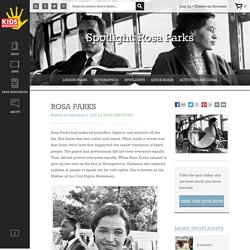
She knew this was unfair and unjust. What made it worse was that there were laws that supported the unjust treatment of black people. The police and government did not treat everyone equally. They did not protect everyone equally. When Rosa Parks refused to give up her seat on the bus in Montgomery, Alabama, she inspired millions of people to speak out for civil rights. Overview. What does "civil rights" mean?

Civil rights are basic rights that every citizen has under the laws of the government. In the United States the civil rights of each individual citizen are protected by the Constitution. Civil rights for every person means that regardless of gender, skin color, religion, nationality, age, disability, or religion, a person should not be discriminated against. Kid's Biography: Martin Luther King, Jr. History >> Biography >> Civil Rights for Kids Martin Luther King at the March on Washingtonby Unknown.
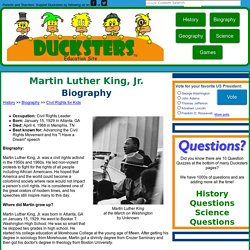
Biography for Kids: Ida B. Wells. History >> Biography >> Civil Rights for Kids Occupation: Journalist, civil rights and women's activist Born: July 16, 1862 in Holly Springs, Mississippi Died: March 25, 1931 in Chicago, Illinois Best known for: Leading a campaign against lynching Biography: Where did Ida B.
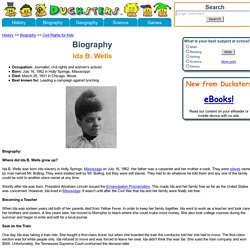
Wells grow up? Civil Rights Movement - History of the Civil Rights Movement. African-American Civil Rights Movement. History >> Civil Rights for Kids March on Washington Aug 28, 1963from the United States Information Agency The African-American Civil Rights Movement was an ongoing fight for racial equality that took place for over 100 years after the Civil War.
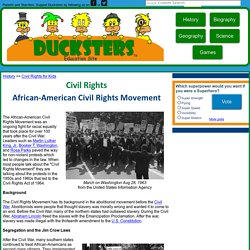
Leaders such as Martin Luther King, Jr., Booker T. Washington, and Rosa Parks paved the way for non-violent protests which led to changes in the law. Montgomery Bus Boycott. History >> Civil Rights for Kids Montgomery Bus Boycott The Montgomery Bus Boycott was one of the major events in the Civil Rights Movement in the United States.

It signaled that a peaceful protest could result in the changing of laws to protect the equal rights of all people regardless of race. Little Rock Nine. History >> Civil Rights for KidsBackground In 1896, the U.S.
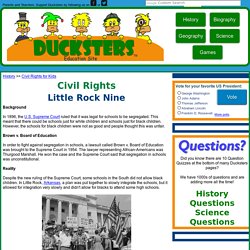
Supreme Court ruled that it was legal for schools to be segregated. This meant that there could be schools just for white children and schools just for black children. However, the schools for black children were not as good and people thought this was unfair. Brown v. In order to fight against segregation in schools, a lawsuit called Brown v. Reality Despite the new ruling of the Supreme Court, some schools in the South did not allow black children. Little Rock Integration Protest by John T. Who were the Little Rock Nine? One of the high schools that blacks were not allowed to attend was Central High School in Little Rock, Arkansas. First Day at School When the Little Rock Nine went to attend the first day of school on September 4, 1957 they were probably scared and worried. The students were scared and they returned home.
Armed Escort Attending School Reaction Results. Birmingham Campaign. History >> Civil Rights for KidsWhat was the Birmingham Campaign?

The Birmingham Campaign was a series of protests against racial segregation in Birmingham, Alabama that took place in April of 1963. Background. Jim Crow Laws. History >> Civil Rights for KidsWhat were the Jim Crow laws?
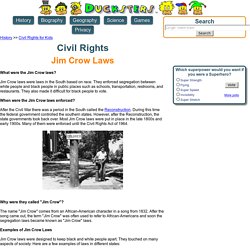
Jim Crow laws were laws in the South based on race. They enforced segregation between white people and black people in public places such as schools, transportation, restrooms, and restaurants. They also made it difficult for black people to vote. When were the Jim Crow laws enforced? March on Washington. History >> Civil Rights for Kids Background to the March Despite gaining their freedom from slavery after the end of the civil war, African Americans were still facing legal discrimination in the 1950s and early 1960s.

This included segregation of schools, lower wages, and discrimination when applying for jobs. Civil Rights Act of 1964. History >> Civil Rights for Kids The Civil Rights Act of 1964 was one of the most important civil rights laws in the history of the United States. It outlawed discrimination, ended racial segregation, and protected the voting rights of minorities and women. Lyndon Johnson signing Civil Rights Actby Cecil Stoughton Background The Declaration of Independence declared that "All men are created equal. " However, when the country was first formed this quote didn't apply to everyone, only to wealthy white landowners. African-American Civil Rights Movement. History of Civil Rights movement, 4th grade Lesson Intro. Biography for Kids: Ruby Bridges. History >> Biography >> Civil Rights for Kids Occupation: Civil Rights Activist Born: September 8, 1954 in Tylertown, Mississippi Best known for: First African-American student to attend an all-white elementary school in the SouthBiography: Where did Ruby Bridges grow up?
Ruby Bridges grew up on a small farm in Tylertown, Mississippi. Her parents were sharecroppers, meaning they farmed the land, but didn't own it. When Ruby was four years old, her family moved to New Orleans. In New Orleans, Ruby lived in a small apartment where she shared a bedroom with her sister and two younger brothers. US Marshals with Young Ruby Bridges on School Steps by Unknown Attending School Ruby went to kindergarten at an all black school. Chosen for Integration One day, Ruby was asked to take a test. At first her father didn't want her to go to the white school. First Day at a White School.